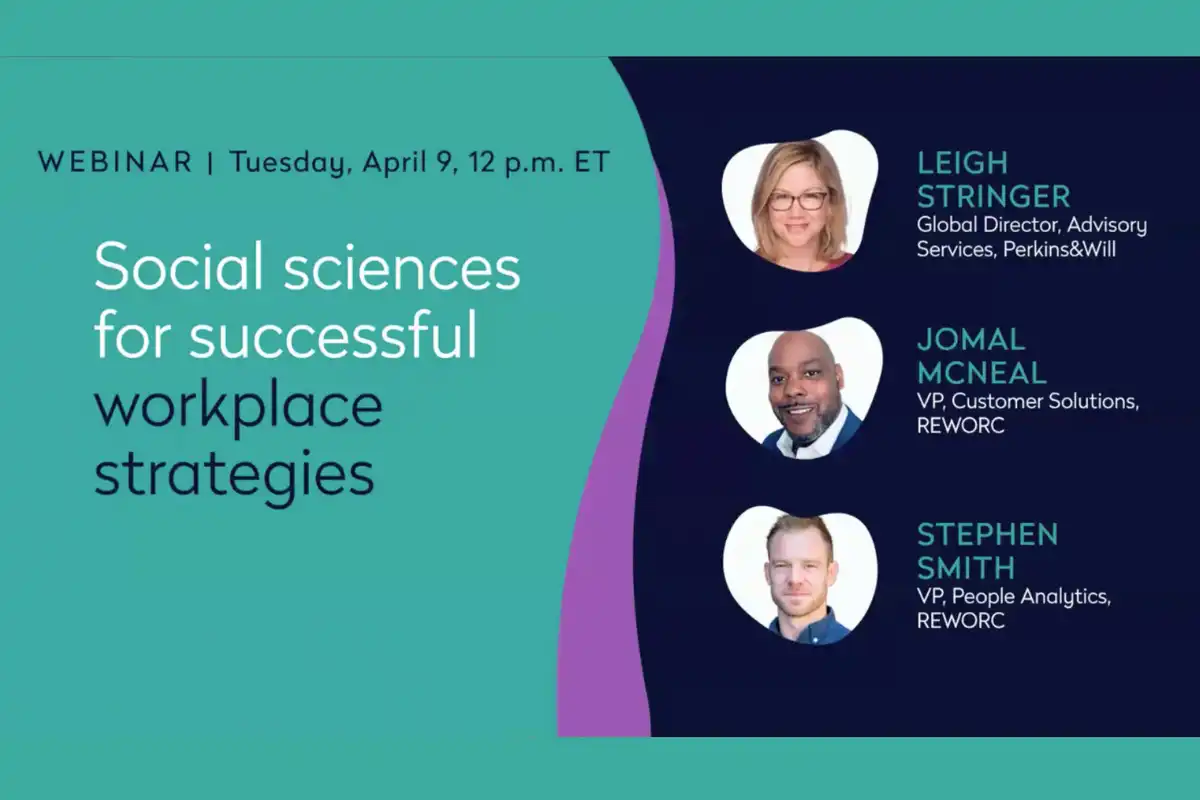
“Social sciences for successful workplace strategies” features a panel of experts sharing actionable insights on the use of social sciences for successful workplace strategies. The webinar covers how by better understanding human behavior, workplace professionals can leverage data for decision-making and create psychologically safe environments. Also included are insights into the role of technology in shaping the future of work.
The panel includes:
- Leigh Stringer, Global Director of Advisory Services, Perkins&Will
- Jomal McNeil, VP of Customer Solutions, REWORC
- Stephen Smith, VP of People Analytics, REWORC
To help you get the most from watching the webinar, here’s an annotated recap with key takeaways, background, and further reading for a more complete understanding of the topics and their importance in modern asset and facility management.
Businesses should not be data-driven, but data-informed
Data is not a complete solution. In fact, the panel argues that while data plays a crucial role in informing decisions, it should not be the sole driver of those decisions.
Stringer explains: “[The industry} keeps saying data is making all the decisions for us. It’s not true. Data is one tool that we have, along with our experience and our expertise to help, you know, make decisions that drive us forward.” Smith adds that organizations should use data to challenge traditional thinking and assumptions, and to drive innovative solutions.
McNeil also wants organizations to be careful about where they’re collecting their data. “At this point, the majority of intelligence within an organization resides at the edge. So, if you’re just pulling insight from the center of the organization, you’re missing out on a huge part of your operations and the potential for improving said organization towards delivering its mission.”
What is data-driven decision-making?
Data-driven decision-making (DDDM) is the process of using data to guide business decisions, where an organization collects, analyzes, and interprets data to uncover patterns, trends, and insights that inform strategic actions. The approach aims to minimize bias, reduce uncertainty, and optimize outcomes by leveraging empirical evidence.
Examples of data-driven decision-making across industries
Data drives decisions across many different industries. For example, Amazon uses data analytics to personalize product recommendations for customers, optimize supply chain logistics, and improve overall customer experience. In entertainment, Netflix leverages data to understand viewer preferences and create personalized content recommendations. A data-driven approach has been instrumental in the success of their original content and user retention. At Google, they use data to optimize search algorithms, improve ad targeting, and enhance user experience across its suite of products, while Airbnb uses data analytics to understand user behavior, optimize pricing strategies, and improve the matching of hosts and guests.
- “We’ve had three big ideas at Amazon that we’ve stuck with for 18 years, and they’re the reason we’re successful: Put the customer first. Invent. And be patient.” – Jeff Bezos, Founder of Amazon
- “We are a data-driven company. We use data to make decisions, not just to support decisions.” – Reed Hastings, Co-Founder and CEO of Netflix
- “We don’t have better algorithms. We just have more data.” – Peter Norvig, Director of Research at Google
- “Data is the voice of the customer. It tells you what’s working and what’s not.” – Brian Chesky, Co-Founder and CEO of Airbnb
Data-driven decision-making in workplace management
By leveraging data, companies can optimize workflows, identify areas for improvement, and make informed decisions that drive growth and innovation. For instance, data can be used to track employee performance, identify training needs, and implement strategies that boost morale and engagement.
Companies like Google and Amazon have shown the power of data-driven workplace strategies. Google’s People Analytics team uses data to understand what makes employees happy and productive, leading to initiatives that improve workplace culture. Amazon’s use of data to optimize warehouse operations has resulted in significant efficiency gains and better working conditions for employees.
Workplace leaders should foster an environment of psychological safety and trust
Creating a psychologically safe environment in the workplace, where employees can express themselves without fear of consequence, is the key to inclusion and building a better workplace culture.
McNeil adds: “At the end of the day, most people, I’d say 99.9% of people have purpose and want to do a good job. And what’s frustrating for them is either leadership getting in the way of them accomplishing their task or the environment or each other.”
Stringer advocates for inclusive discussions that allow input from a diverse group of people, arguing that “Everyone who’s interested in this particular topic, join in because you never know what expertise is like inside of people.”
What is an inclusive workplace?
Inclusion in the workplace means actively involving and engaging all employees, regardless of their differences. It’s about ensuring that everyone has equal access to opportunities and resources, and that their voices are heard and considered. Inclusion goes beyond mere diversity; it’s about creating a sense of belonging and ensuring that everyone feels they can contribute to the organization’s success.
Benefits of an inclusive workplace
Focusing on inclusiveness can deliver many benefits, including:
- Improved decision-making: Diverse teams bring a variety of perspectives, leading to more innovative and effective solutions
- Enhanced employee engagement: When employees feel valued and included, they are more likely to be engaged and committed to their work
- Increased productivity: Inclusive workplaces often see higher levels of collaboration and teamwork, leading to increased productivity
- Better talent attraction and retention: Companies that prioritize inclusion are more attractive to job seekers and are better at retaining top talent
- Enhanced reputation: A commitment to inclusion can improve a company’s brand and reputation, making it more appealing to customers and partners
Companies can track their progress using a variety of methods and metrics like employee surveys, performance reviews, and employee resource groups.
Understanding and leveraging insights from social sciences is crucial for successful workplace strategies
Tracking behavior is important, but workplace leaders also need to understand why people behave the way they do.
Smith cautions: “People can game these systems. And the longer we keep trying to count things the way we do as if we’re industrial re, you know, industrial employees, the more we’re going to miss the mark.”
Stringer then explains that understanding how people feel about the space they work in is just as important as how much time they spend there.
McNeil emphasizes the need for a deeper understanding of others rather than just self-awareness. “What’s important is that we get outside of our comfort zones. Look, FM real estate touches every part of the business, each of the business units… I would encourage them to get in touch with each of those leaders and understand their mission, their goal and then start to talk about or draw the dotted line of how the environment, both on site and distributed, contributes to those goals.”
What are the social sciences, and what can they reveal about human behavior?
Social sciences are a group of academic disciplines that study human behavior, interactions, and societies. They include fields like psychology, sociology, anthropology, economics, political science, and history. These disciplines use scientific methods to collect and analyze data, helping us understand various aspects of human life and society.
Psychology
Focuses on the mind and behavior. It can provide insights into individual thoughts, emotions, and actions. For example, psychologists study how people perceive the world, learn, remember, and interact with others. They also explore topics like personality, mental health, and the influence of environment on behavior.
Sociology
Examines social behavior and interactions, with a focus on the groups, institutions, and societies that people form. It can help with understanding how social structures and cultural norms influence human behavior; sociologists study topics such as social class, race, gender, family, religion, and the impact of technology on society.
Anthropology
Studies human beings, both past and present, and their cultural, biological, and environmental aspects. It can offer insights into how cultural differences and similarities shape human behavior across different societies; anthropologists explore topics like language, cultural practices, human evolution, and the relationship between humans and their environments.
Economics
Explores the production, distribution, and consumption of goods and services. It can reveal how people make decisions, allocate resources, and respond to incentives, providing a window into human behavior in the context of markets and economies; economists study topics such as supply and demand, economic growth, inflation, and unemployment.
Political science
Looks at political systems, institutions, and behaviors. It can help with understanding how people engage with politics, make collective decisions, and exercise power within societies; political scientists explore topics like democracy, authoritarianism, international relations, public policy, and political ideologies.
History
Examines past events and their impact on human societies. It can provide context for understanding how human behavior has evolved over time and how historical events shape contemporary behaviors and attitudes; historians study topics such as wars, revolutions, social movements, cultural changes, and the rise and fall of civilizations.
These areas offer a deeper understanding of why people act the way they do, how societies function, and how to improve human well-being. Additionally, interdisciplinary approaches that combine insights from multiple social sciences can offer even more comprehensive perspectives on human behavior and societal dynamics.








